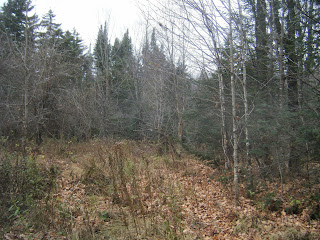A
couple of weeks ago I received an email from someone wanting to know where to
locate good grouse cover. They had recently acquired a German shorthair pointer
and thought grouse hunting sounded like fun. That certainly sounded like a backward way to come at the sport. On the plus side, they had joined
local chapters of the North American Versatile Hunting Dog Association and
Ruffed Grouse Society, both excellent organizations.
 |
| Typical old cutting in the Northeast. |
There
probably is no better way to start than joining the Ruffed Grouse Society and a
hunting dog group. At least then you will meet likeminded people who are bound
to share some of their bird hunting knowledge. Whether you can get them to open
up and share their favorite coverts may be another matter though. Grouse
coverts are hard earned and shared sparingly.
State
fish and game departments usually have experts that can point you in the right
direction. When you are up in bird country, if you should happen upon any
fishermen, hikers, and loggers, it doesn’t hurt to ask if they’ve seen any
grouse. Most aren’t bird hunters and will gladly share what they know. And it
doesn’t hurt to talk to sales people in local sporting goods stores, although
dyed in wood grouse hunters aren’t all that common and salespeople are…well,
salespeople, and likely to tell you what they think you want to hear.
 |
| The nearby softwoods provide shelter. |
Other
than that, I would pick a part of the country where there is still an abundance
of timber harvesting and study it on Google Earth. Logging roads and activity
such as clear cuts show up readily. Soft woods are easy to see, which provide
shelter. An hour spent studying the images on Google Earth and the
topographical maps of the area can save you days of walking.
The
next step is to go to the locations that you’ve picked and to start walking.
You are looking for shelter for the birds and a food source. Remember that
available food changes with the seasons and what you see in the summer may not
be there in the fall. A nearby stream is a plus. Logging roads can provide grit
for the birds. Maybe you’ll be lucky enough to find a drumming log. Maybe you’ll
even bust a large covey of grouse.
 And
then plan to come back in the fall with your dog. If you’ve done your homework and hit
pay dirt, you’ve found your first grouse covert. It is up to you whether you
want to share it or not.
And
then plan to come back in the fall with your dog. If you’ve done your homework and hit
pay dirt, you’ve found your first grouse covert. It is up to you whether you
want to share it or not.
I have this question quite often. I rarely reveal my precious spots that yield good numbers. I do give the same kind of advice you and all other wise bird hunters give out..."put some boot leather on the ground and do some homework...then tell me what you find." The internet, while helpful and full of info if you have the time to scour it, has made us even more an "instant gratification" society. While I could continue to bemoan the evils of the technology of our time, I choose rather to look upon it with a slight amusement. I can personally use the internet for my purposes, and then go "old school" with the dwindling numbers of brushworns who still know how to have a good time (and maybe find a bird or two in the process.) Thanks for the blog it's always a good read.
ReplyDelete